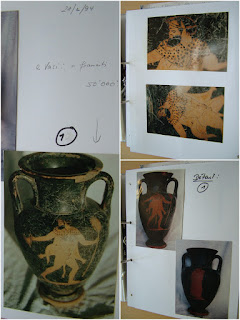Wednesday, March 15, 2017 -  art crime,art crime in war,Bosnia and Herzegovina,Bosnia-Herzegovina,Centar Protiv Krijumčarenja Umjetninama,CPKU,illicit trafficking,looted antiquities,looted art,Yugoslavia
art crime,art crime in war,Bosnia and Herzegovina,Bosnia-Herzegovina,Centar Protiv Krijumčarenja Umjetninama,CPKU,illicit trafficking,looted antiquities,looted art,Yugoslavia
 2 comments
2 comments
 art crime,art crime in war,Bosnia and Herzegovina,Bosnia-Herzegovina,Centar Protiv Krijumčarenja Umjetninama,CPKU,illicit trafficking,looted antiquities,looted art,Yugoslavia
art crime,art crime in war,Bosnia and Herzegovina,Bosnia-Herzegovina,Centar Protiv Krijumčarenja Umjetninama,CPKU,illicit trafficking,looted antiquities,looted art,Yugoslavia
 2 comments
2 comments
Fighting Art Trafficking and Art Crime in Bosnia: the work of CPKU
The importance of South East Europe as a major route for the illicit trafficking of looted and stolen art and antiquities, as well as a source region itself is recognised by international art crime researchers and professionals. However, the activities of the Tuzla-based Center Against Trafficking in Works of Art (Centar Protiv Krijumčarenja Umjetninama – CPKU), the only organisation in Bosnia-Herzegovina dedicated to documenting and fighting art crime, is not as well-known as it should be.
CPKU is also playing a role in focusing attention on one of the great unanswered questions of the 1992–1995 Bosnian War: that of the enormous amount of cultural property looted during the conflict. This has never been adequately addressed, either with regard to the detailed documentation of missing objects, or investigation of the movement, destination and whereabouts of looted cultural property. Nor (so far as the author is aware) have any formal claims for restitution of looted cultural property been made by governmental or institutional authorities.
Since the centre was established in December 2014, CPKU has worked to establish a national system of coordination and cooperation on art crime between national and international agencies and owners of cultural property (both public and private). Yet despite being the only state-wide organisation working in the field, the centre is often told by international bodies that as an NGO it does not have the authority to deal with these issues. However, as CPKU’s founder-director Dženan Jusufović has pointed out, official bodies which should be dealing with such issues, simply aren’t. Nevertheless, CPKU is having a significant impact in creating a greater awareness of the issue in official bodies and continues to forge a growing number of links with law enforcement and judicial agencies in Bosnia-Herzegovina.
In October 2015 CPKU convened its first major event, a roundtable conference on the illicit traffic in art in Bosnia-Herzegovina, which brought together over 40 representatives from key stakeholders engaged in the fight against organised crime and war crimes, including international, national and entity agencies and law enforcement bodies, as well as from cultural institutions such as museums and galleries, alongside private collectors and NGOs.
Growing out of the conference were calls for the creation of a national database of missing works of art and other cultural property, for training in art crime for law enforcement officers, prosecutors and the judiciary, and for the formation of specialised art crimes units. Parallel with this, the holders of cultural goods (whether public or private) were urged to assist in the fight against the illicit traffic in cultural property by regularly updating their documentation of objects (including making good quality photographic documentation).
Since then CPKU has produced guidelines for documenting works of art and reporting thefts, as well as providing detailed instructions on the best ways of photographing objects for documentation purposes (both downloadable from the CPKU website). Last year it published the first manual (also downloadable ) on the illicit art trade in Bosnia-Herzegovina which incorporates information on the legal international and national legal framework, how art is trafficked across the country and the region, and suggested preventive measures, as well as reproducing the sample documentation instructions.
A public awareness-raising event/performance, Giants of Art (Velikani Likovne Umjetnosti), was held in partnership with the National Gallery of Bosnia-Herzegovina and the Association of Artists of Bosnia-Herzegovina at the Sarajevo-based gallery in April 2016 to alert the wider public to the issue of missing works of art – some of which had no photographic documentation.
All these initiatives have been supported by CPKU’s principal partner, the French Embassy in Sarajevo. The embassy was also instrumental in bringing Corinne Chartrelle, Deputy Head of France’s L'Office Central de Lutte Contre le Trafic de Biens Culturels (OCBC), to speak at a recent CPKU seminar on the illicit art market at the headquarters of the Centre for Judicial and Prosecutorial Training of the Federation of Bosnia-Herzegovina (CEST).
By May 2017 CPKU hopes to release a database of artworks missing or stolen from Bosnia-Herzegovina. Dženan Jusufović has noted that only thirteen cases of stolen artwork from Bosnia are registered on Interpol’s database of stolen art, despite that thousands of items of cultural property disappeared during or in the aftermath of the 1992–1995 war.
In addition to ongoing support from the French Embassy, CPKU also has partnerships or cooperation with national and international bodies and institutions, including ICOM Observatory, Interpol, UNESCO, ICOM Bosnia-Herzegovina, the Centre for Judicial and Prosecutorial Training of the Federation of Bosnia-Herzegovina (CEST), the British Council, the National Gallery of Bosnia-Herzegovina, the Historical Museum of Bosnia-Herzegovina, the Association of Artists of Bosnia-Herzegovina, the Faculty of Law at University of Tuzla, the NGO Akcija, and other museums, galleries, heritage institutions and legal-judicial bodies.
For further information contact:
Centar Protiv Krijumčarenja Umjetninama (CPKU)
Atelje Ismet Mujezinović
Klosterska 19
75000 Tuzla
Bosnia-Herzegovina
Email: cpkubih [at] gmail [dot] com
Phone: +387 61 185 733
Website: www.cpku.org
Facebook: Centar-protiv-krijumčarenja-umjetninama




















